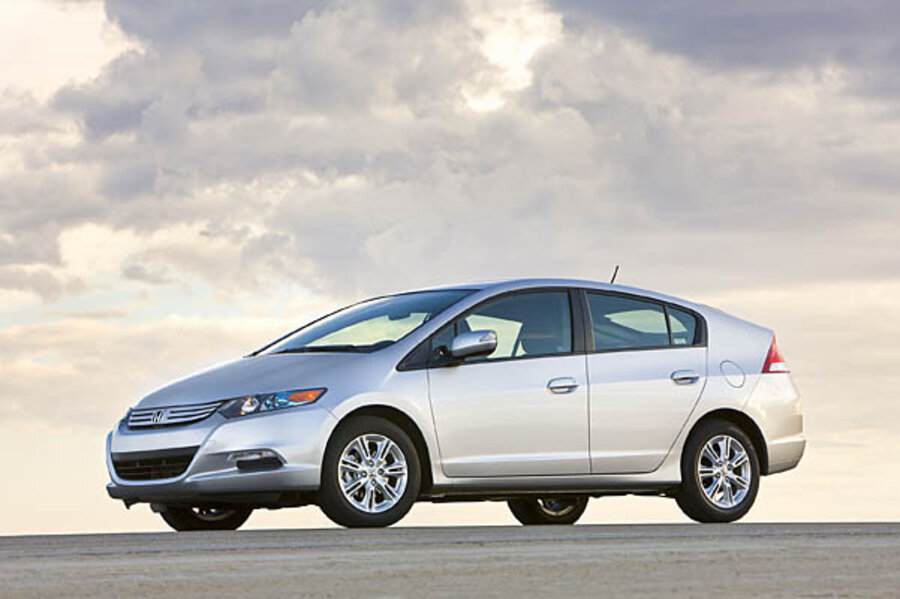Honda hybrids go bigger; Insight axed
Loading...
Scrambling to do a bit of damage control after news broke last month that production of its Insight hybrid will end this year, Honda issued a press release touting its renewed commitment to hybrid technology.
The death of the Insight model begged the question, what about the tiny two-seat CR-Z hybrid hatchback?
And, for that matter, what about the Civic Hybrid sedan too, now in its third generation but still saddled with Honda's aging mild-hybrid system?
In response to a question from Green CarReports, Honda said only that there are "no production changes" to the CR-Z and Civic Hybrid models at this time.
Meanwhile, the replacement for Honda's 15-year-old Integrated Motor Assist (IMA) mild-hybrid system, known in Japan as i-DCD (for intelligent Direct Clutch Drive), will apparently not come to the U.S. in either of the two vehicles it's fitted to in Japan.
Those are the new 2015 Honda Fit and the subcompact crossover known as the Honda Vezel, which may be renamed for the U.S. before it goes on sale this summer or fall.
Both are subcompacts, and in the U.S., the gas savings from the i-DCD system are not likely to be offset by the cost of the new system, which has a more powerful 22-kilowatt (30-horsepower) electric motor sandwiched between the cars' 1.5-liter four-cylinder engine and a seven-speed direct-shift gearbox.
But back to that Honda press release.
It says that Honda has committed to the expansion of its hybrid offerings in the U.S.
Specifically, Honda is "reinforcing its commitment to a clear product strategy focused on further advancing fuel-efficient and alternative-fuel vehicle technologies that are better aligned with customer needs and that strengthen the company's U.S. sales momentum."
Translated, that means that customers weren't that interested in its mild hybrids, and the company will instead focus in the U.S. on the new two-motor hybrid system launched in the 2014 Honda Accord Hybrid and Accord Plug-In Hybrid.
Supplies of the Accord Hybrid have been limited as production ramps up at the Ohio factory where it's built (though the low-volume plug-in hybrid is imported from Japan).
But unlike subcompacts, where Honda had the field to itself before the launch of the 2012 Toyota Prius C--which trounced the Insight in sales--the new Accord Hybrid competes in a well-established segment: mid-size hybrid sedans.
The segment was pioneered in 2006 by the Toyota Camry Hybrid, joined in 2010 by the Ford Fusion Hybrid. Both those cars are now in their second generation, and were joined in 2011 by the Hyundai iSonata Hybrid and Kia Optima Hybrid--both of which were updated for 2013 to improve the drive quality of their hybrid systems.
In other words, Honda is going to the heart of the market with its new hybrid technology--which now gives full-hybrid capabilities, including all-electric running under light loads.
What Honda hasn't addressed, however, is whether that system--or its new, smaller i-DCD system--could appear in an updated version of its well-established Civic Hybrid.
The Civic is a compact sedan, not a subcompact like the Insight, CR-Z, and 2015 Fit, and the hybrid Civic starts at $25,435 (including the mandatory delivery fee).
That's $10,000 above some subcompact prices, and it makes us think that the Civic Hybrid could justify the added cost of a new and more powerful system.
And the company has said that the Accord won't be the only vehicle to use the new two-motor hybrid system, specifically citing "expanded applications" of the system in its release.
Which begs a question of its own: Might we also see a hybrid Pilot crossover or, perhaps even more attractive to families (judging from our comments), a hybrid Odyssey minivan?
Honda's not commenting on those possibilities either.
But if or when it does, you'll read it here.







